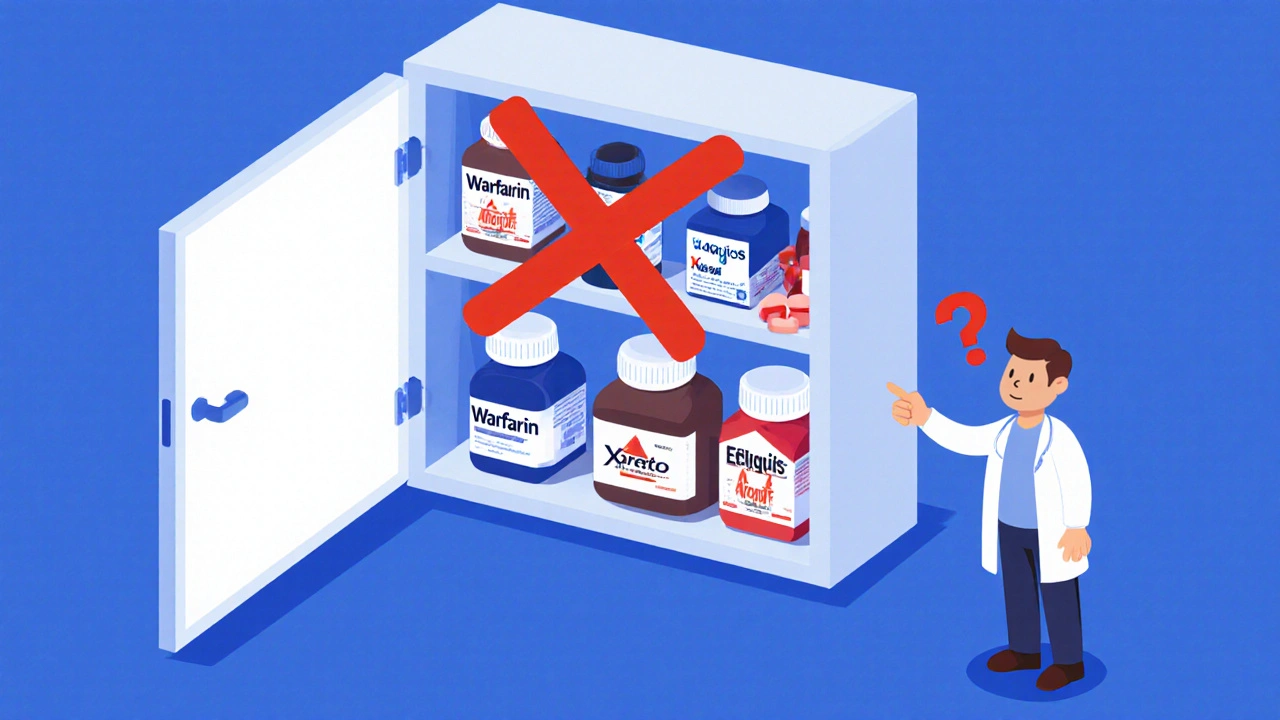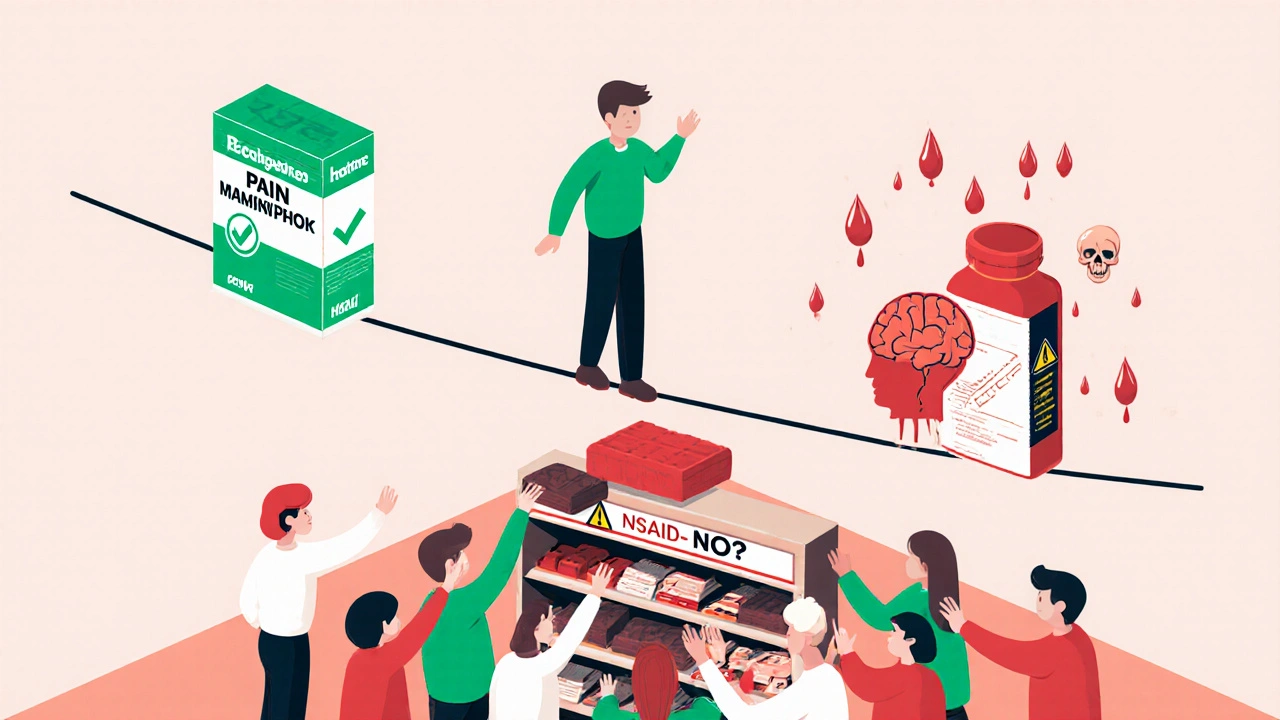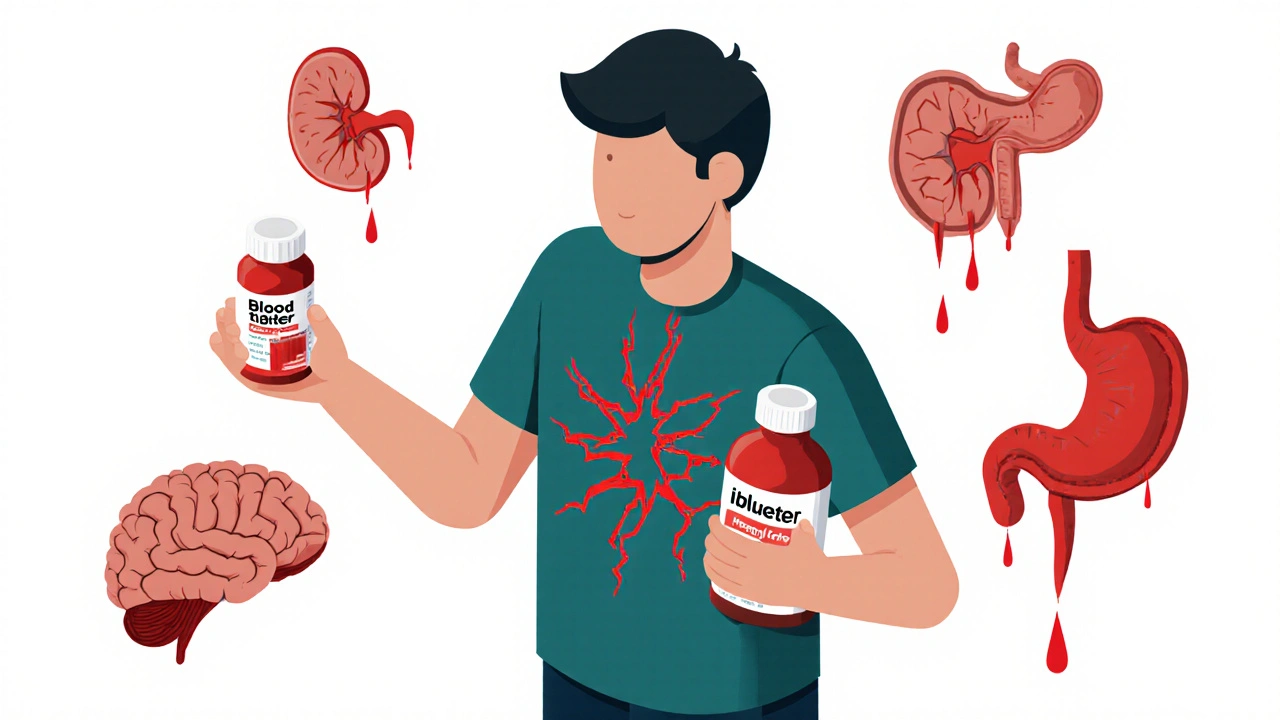If you're taking a blood thinner-whether it's warfarin, apixaban, rivaroxaban, or another anticoagulant-and you reach for ibuprofen or naproxen to ease a headache, sore knee, or back pain, you're putting yourself at serious risk. This isn't a theoretical warning. It's a proven, life-threatening combination that sends thousands to the hospital every year. The danger isn't just about stomach bleeding. It's about bleeding in your brain, lungs, kidneys, and elsewhere-often without warning.
The Real Risk: More Than Just an Upset Stomach
Most people think the danger of mixing blood thinners with NSAIDs is limited to stomach ulcers or gastrointestinal bleeding. That’s only part of the story. A massive 2024 study from Denmark, tracking over 51,000 people on anticoagulants, showed that adding an NSAID doesn’t just raise the chance of a bleeding stomach-it multiplies the risk across the entire body.- People taking both drugs had a 2.24 times higher risk of gastrointestinal bleeding
- They were 3.22 times more likely to suffer a brain bleed
- Pulmonary bleeding risk jumped by 36%
- Urinary tract bleeding risk rose by 57%
- Anemia from blood loss became nearly three times more common
Which NSAIDs Are the Most Dangerous?
Not all NSAIDs are created equal when mixed with blood thinners. The Danish study broke down the risk by drug:- Naproxen: 4.1 times higher bleeding risk
- Diclofenac: 3.3 times higher risk
- Ibuprofen: 1.79 times higher risk
How Blood Thinners and NSAIDs Work Together to Cause Bleeding
Blood thinners work by slowing down your body’s ability to form clots. Anticoagulants like warfarin and DOACs (direct oral anticoagulants) target clotting proteins in your blood. NSAIDs like ibuprofen and naproxen attack a different system: they block cyclooxygenase (COX) enzymes. This reduces inflammation and pain-but it also stops platelets from sticking together when they should. Think of it like this: your blood needs both clotting factors and platelets to seal a cut. Blood thinners weaken the clotting side. NSAIDs weaken the platelet side. Together, they leave you with almost no way to stop bleeding-even from a tiny nick. And here’s what most people don’t realize: this risk is the same whether you’re on old-school warfarin or a newer DOAC. There’s no "safer" blood thinner when NSAIDs are in the picture. The Danish study confirmed this across all types.
Why Over-the-Counter Doesn’t Mean Safe
Many patients don’t even think of ibuprofen or naproxen as "medications." They grab them off the shelf like aspirin or cough syrup. But in Denmark, where the study was done, 75% of ibuprofen use is prescription-based. In the U.S., it’s the opposite-billions of OTC tablets are sold every year. That’s a huge problem. Doctors can’t warn you about a drug they don’t know you’re taking. If you say, "I don’t take any meds besides my blood thinner," and you’re popping Advil for your arthritis, your doctor has no idea you’re in danger. The American College of Cardiology says this interaction is so common-and so dangerous-that health systems need to build systems to catch it. That means pharmacists checking your profile before dispensing, EHRs flagging the combo, and clinicians asking specifically: "Are you taking any pain relievers, even over-the-counter ones?"What Should You Take Instead?
The answer is simple: acetaminophen (Tylenol). Unlike NSAIDs, it doesn’t affect platelets or stomach lining. It’s not as strong for inflammation, but it’s effective for pain and doesn’t raise your bleeding risk. For most people on blood thinners, it’s the only painkiller you should use regularly. If you need something stronger for inflammation-say, for gout or severe arthritis-talk to your doctor. Options include:- Physical therapy
- Heat or cold packs
- Topical creams (like diclofenac gel-applied to the skin, not swallowed)
- Prescription non-NSAID pain relievers

What to Do Right Now
If you’re on a blood thinner:- Check your medicine cabinet. Do you have ibuprofen, naproxen, diclofenac, or aspirin? If yes, don’t use them unless your doctor says it’s okay.
- Ask yourself: Have you taken any of these in the last 30 days? Even once?
- Call your doctor or pharmacist. Tell them exactly what pain relievers you’ve used, even if you think it’s "just occasional."
- Switch to acetaminophen for pain. It’s available without a prescription and is safe with anticoagulants.
Why This Problem Is Getting Worse
More people are on blood thinners than ever before. Atrial fibrillation, deep vein thrombosis, and other clotting conditions are rising with age and chronic disease. At the same time, chronic pain-especially from arthritis-is common in the same population. The perfect storm. The American Heart Association warned in 2019 that this combination is likely to increase as both conditions grow more common. And with OTC NSAIDs so easy to get, patients often don’t connect the dots until it’s too late. This isn’t just a medical issue. It’s a public health crisis hiding in plain sight. Millions of people think they’re being smart by using "over-the-counter" painkillers. They’re not. They’re playing Russian roulette with their internal bleeding risk.Final Word: Don’t Guess. Ask.
Your blood thinner is prescribed for a reason. It’s keeping you alive. NSAIDs? They’re a convenience. And convenience shouldn’t outweigh safety. If you’re unsure whether a pain reliever is safe with your blood thinner, don’t assume. Don’t Google it. Don’t ask a friend. Call your doctor or pharmacist. Show them the bottle. Ask: "Is this safe with my anticoagulant?" There’s no shame in asking. There’s only danger in assuming.Can I take ibuprofen with warfarin if I only use it once in a while?
No. Even occasional use of ibuprofen with warfarin increases your risk of bleeding by nearly 80%. There’s no safe "occasional" dose. The combination affects your blood’s ability to clot systemically-not just in your stomach. Acetaminophen is the only recommended over-the-counter pain reliever for people on warfarin.
Are newer blood thinners like Eliquis or Xarelto safer with NSAIDs than warfarin?
No. The 2024 Danish study found no difference in bleeding risk between warfarin and newer DOACs like apixaban (Eliquis) or rivaroxaban (Xarelto) when combined with NSAIDs. The danger comes from the NSAID’s effect on platelets and stomach lining, not from the type of anticoagulant. All blood thinners carry this same risk when mixed with NSAIDs.
What about topical NSAIDs like Voltaren gel? Are they safe?
Topical NSAIDs like diclofenac gel are much safer than oral versions because very little of the drug enters your bloodstream. Studies show they don’t significantly increase bleeding risk in people on blood thinners. They’re a good option for localized pain like arthritis in the knee or elbow. But avoid applying them over large areas or for long periods without checking with your doctor.
Can I take aspirin with my blood thinner?
Aspirin is an NSAID and an antiplatelet drug. It blocks platelets just like ibuprofen and naproxen. Taking aspirin with a blood thinner dramatically increases bleeding risk-even at low doses like 81 mg. Unless your doctor specifically prescribed low-dose aspirin for heart protection (which is rare now), you should avoid it entirely while on anticoagulants.
What should I do if I accidentally took ibuprofen with my blood thinner?
If you took one or two doses of ibuprofen by accident, monitor yourself closely for signs of bleeding: unusual bruising, dark or tarry stools, blood in urine, dizziness, or severe headaches. Call your doctor immediately. Don’t wait for symptoms. Even a single dose can tip the balance in vulnerable individuals. Going forward, remove all NSAIDs from your home and replace them with acetaminophen.
Is there a blood thinner that doesn’t interact with NSAIDs?
No. All anticoagulants-whether warfarin, dabigatran, rivaroxaban, apixaban, or edoxaban-interact dangerously with NSAIDs. The mechanism of interaction involves platelet function and stomach lining protection, which NSAIDs disrupt regardless of the anticoagulant used. There is no exception.
Can I use CBD or turmeric as a natural alternative to NSAIDs?
CBD and turmeric are not proven alternatives to NSAIDs for pain relief, and they may also affect blood clotting. Some studies suggest CBD can interact with liver enzymes that process blood thinners, potentially increasing their levels in your blood. Turmeric contains curcumin, which has mild antiplatelet effects. Neither is a safe substitute without medical supervision. Stick with acetaminophen and non-drug therapies like heat, ice, or physical therapy.
If you're on a blood thinner, your pain management plan should be reviewed regularly-not just when you feel bad. Talk to your doctor about long-term strategies. Your safety isn't worth risking for a quick fix.
